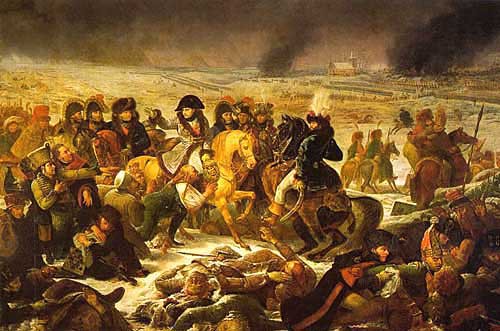The tragic and bloody Battle of Eylau, with its appalling loss of human life – nearly 50,000 dead and wounded – was, just as Marengo had been before it, the subject of a major propaganda campaign. The aim was on the one hand to confirm the French victory but on the other to guide French perception of the event and through that to control public opinion. In addition to the Grande Armée Bulletins, the articles and eyewitness accounts published in the press, official communiqués, and the writing of an official version of the battle, the ‘Relation de la bataille’, published jointly in Paris and Berlin, there was public competition for painting commission showing Napoleon on the battlefield the day after the fight, directing the men bringing assistance to the wounded. The competition announcement, written by Vivant Denon on 7 March, 1807, one month after the battle, explicitly dictated the iconographical programme, and it was published in the newspapers on 2 April. The sketches by the 26 artists taking part in the competition were exhibited in the Galerie d’Apollon of the Musée Napoléon (today’s Louvre). Gros was chosen on 13 June and his painting, presented at the Salon of 1808, brought him the Légion d’honneur.
Vivant Denon’s iconographical programme was very detailed, specifying the topography, the figures to be shown, and their dress, and Gros was to follow the instructions to the letter. The gloomy day is darkened by black smoke emanating from fire, Napoleon is crossing the snowy battlefield accompanied by Berthier, Bessières and Caulaincourt to the left, and Soult, Davout and Murat to the right. In the foreground, the viewer is presented with the horrific image of corpses and wounded piled up on the ground, a vision designed “to instil in princes a love of peace and a horror of war” as the 64th Grande Armée Bulletin put it.
The equestrian portrait of the war chief, a classic since antiquity, is enhanced with a Christ-like aura. With his pale face turned slightly to heaven, symbolising deep affliction, and his hand stretched out, Napoleon here seems to giving his benediction. Set alongside the dark silhouette of Murat on his rearing charger, the disturbing personification of the warrior, the emperor is all humanity and compassion, even extending generosity to enemy soldiers. “The consoling expression of the great man seems to soften the horrors of death and spread a softer light on this scene of carnage” wrote Vivant Denon. Gros here perfectly executed the programme by also depicting the reactions of the Russians to such magnanimity: they seem to express admiration, gratitude and even devotion! But beyond the propaganda, we are presented with the dark side of victory, and it is shown for the first time in all its obscene reality.
Karine Huguenaud (tr. P.H.)
February 2007


